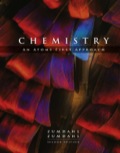
Concept explainers
(a)
Interpretation: The structures for the major products of the given reactions are to be drawn.
Concept introduction: When reagents such as
To determine: The structure for the major product of the given reaction.
(b)
Interpretation: The structures for the major products of the given reactions are to be drawn.
Concept introduction: When reagents such as
To determine: The structure for the major product of the given reaction.
(c)
Interpretation: The structures for the major products of the given reactions are to be drawn.
Concept introduction: When reagents such as
To determine: The structure for the major product of the given reaction.
(d)
Interpretation: The structures for the major products of the given reactions are to be drawn.
Concept introduction: When reagents such as
To determine: The structure for the major product of the given reaction.
(e)
Interpretation: The structures for the major products of the given reactions are to be drawn.
Concept introduction: When reagents such as
To determine: The structure for the major product of the given reaction.
Want to see the full answer?
Check out a sample textbook solution
Chapter 21 Solutions
Chemistry: An Atoms First Approach
- Alcohols are very useful starting materials for the production of many different compounds. The following conversions, starting with 1-butanol, can be carried out in two or more steps. Show the steps (reactants/catalysts) you would follow to carry out the conversions, drawing the formula for the organic product in each step. For each step, a major product must be produced. (See Exercise 62.) (Hint: In the presence of H+, an alcohol is converted into an alkene and water. This is the exact reverse of the reaction of adding water to an alkene to form an alcohol.) a. 1-butanol butane b. 1-butanol 2-butanonearrow_forward1. Dehydration: 2. Oxidation: This is a reaction where an alcohol loses a water molecule to form an alkene. For example, when ethanol is treated with an acidic catalyst, such as sulfuric acid, it undergoes dehydration to form ethene (CH2=CH2) and water. ALCOHOLS In this reaction, an alcohol is converted to either a carbonyl compound or a carboxylic acid. 3. Esterification: Types of Reaction (s) For example, primary alcohols can be oxidized to aldehydes or carboxylic acids, while secondary alcohols can be oxidized to ketones. Tertiary alcohols are usually not affected by oxidations 4. Substitution: The conversion of an alcohol and a carboxylic acid to an ester and water, in the presence of an acid catalyst. The reaction between methanol and acetic acid to form methyl acetate: CH3OH + CH3COOH CH3COOCH3 + H2O Click to add speaker notes ME Substitution reactions in organic chemistry involve the replacement of one atom or group of atoms with another atom or group of atoms in a molecule. 1.…arrow_forward1. Which of the following formulas is incorrect?a. CaNO3b. MgSc. AlBr3d. Li2Oe. NaOH 2. Part of an organic molecule where most of its chemical reactions occur.a. Substrateb. Productc. Reactantsd. Functional Group 3. An acyclic unsaturated hydrocarbon that contains one or more carbon-carbon triple bonds. As the family name alkyne indicates the characteristics ending associated with a triple bond. It has a general formula of one triple bond is CnH2n-2.a. Alkenesb. Alkynesc. Aromatic compoundd. Cycloalkanearrow_forward
 Chemistry: The Molecular ScienceChemistryISBN:9781285199047Author:John W. Moore, Conrad L. StanitskiPublisher:Cengage Learning
Chemistry: The Molecular ScienceChemistryISBN:9781285199047Author:John W. Moore, Conrad L. StanitskiPublisher:Cengage Learning
 ChemistryChemistryISBN:9781305957404Author:Steven S. Zumdahl, Susan A. Zumdahl, Donald J. DeCostePublisher:Cengage Learning
ChemistryChemistryISBN:9781305957404Author:Steven S. Zumdahl, Susan A. Zumdahl, Donald J. DeCostePublisher:Cengage Learning Chemistry: An Atoms First ApproachChemistryISBN:9781305079243Author:Steven S. Zumdahl, Susan A. ZumdahlPublisher:Cengage Learning
Chemistry: An Atoms First ApproachChemistryISBN:9781305079243Author:Steven S. Zumdahl, Susan A. ZumdahlPublisher:Cengage Learning World of Chemistry, 3rd editionChemistryISBN:9781133109655Author:Steven S. Zumdahl, Susan L. Zumdahl, Donald J. DeCostePublisher:Brooks / Cole / Cengage Learning
World of Chemistry, 3rd editionChemistryISBN:9781133109655Author:Steven S. Zumdahl, Susan L. Zumdahl, Donald J. DeCostePublisher:Brooks / Cole / Cengage Learning Chemistry for Today: General, Organic, and Bioche...ChemistryISBN:9781305960060Author:Spencer L. Seager, Michael R. Slabaugh, Maren S. HansenPublisher:Cengage Learning
Chemistry for Today: General, Organic, and Bioche...ChemistryISBN:9781305960060Author:Spencer L. Seager, Michael R. Slabaugh, Maren S. HansenPublisher:Cengage Learning





